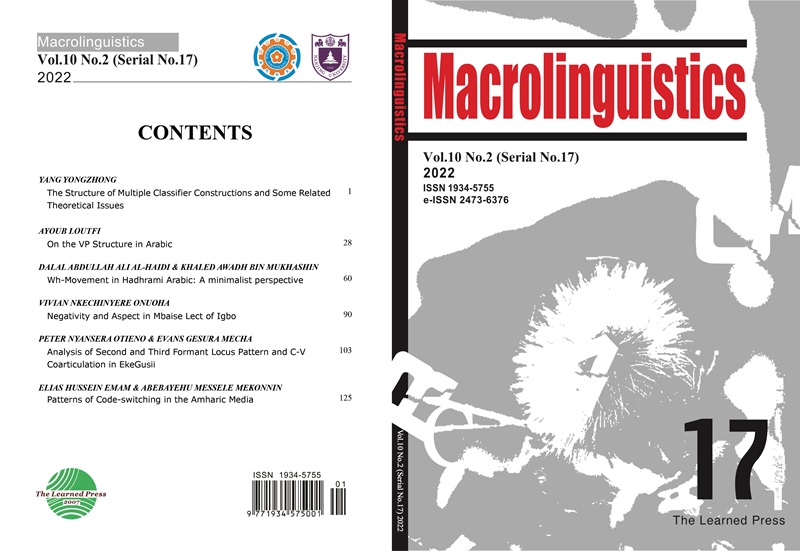Analysis of Second and Third Formant Locus Pattern and C-V Coarticulation in EkeGusii
引用次数: 0
Abstract
This study analyses locus equations and regression lines relating to second and third formants as a measure of co-articulatory influence of vowels following stop consonants in EkeGusii. Coarticulation can be represented statistically using a schematic representation of locus equations by tracking consonant-vowel (CV) transition as a useful tool in the discrimination of place of articulation. Acoustic data was collected using Praat version 6.0 from four males and four females, native speakers of EkeGusii. Locus equations for the eight speakers were derived from CV words with intervocalic voiceless bilabial /p/, voiceless alveolar /t/ and voiceless velar /k/ preceding vowel /i/, /a/ and /o/ contexts. Scatter plots of locus equation of F2 and F3 onsets-F2 and F3 midpoints revealed patterns for each of the three voiceless stops in EkeGusii. The strongest degree of coarticulation is reported for velars then bilabials and the least degree of coarticulation with alveolars.埃克古斯属第二、第三构象位点模式及C-V协同接合分析
本研究分析了埃克古斯语中第二个和第三个共振峰的轨迹方程和回归线,以衡量元音在停止辅音后的共同发音影响。通过跟踪辅音-元音(CV)过渡,可以用轨迹方程的示意图来统计地表示协同发音,这是辨别发音位置的有用工具。使用Praat 6.0版本采集以埃克古斯语为母语的4名男性和4名女性的声学数据。这8位说话者的轨迹方程来源于CV单词中不发音的双元音/p/、不发音的肺泡/t/和不发音的前元音/i/、/a/和/o/语境。F2和F3发病位点方程的散点图-F2和F3中点显示了EkeGusii三个不发音停顿的模式。据报道,腭骨的协同关节度最高,其次是双颊,而与牙槽骨的协同关节度最低。
本文章由计算机程序翻译,如有差异,请以英文原文为准。
求助全文
约1分钟内获得全文
求助全文
来源期刊
自引率
0.00%
发文量
83
审稿时长
20 weeks
期刊介绍:
Macrolinguistics (ISSN 1934-5755, e-ISSN 2473-6376) is an international academic journal which is specialized in research papers of non-Indo-European linguistics. It is published biannually by The Learned Press and funded by the Double First-Class Initiative of Nanjing University. It aims at contributing to the complementarity and interaction of linguistic research worldwide.

 求助内容:
求助内容: 应助结果提醒方式:
应助结果提醒方式:


